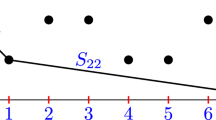Abstract
We prove that if k is a positive integer and d is a positive integer such that the product of any two distinct elements of the set {k + 1, 4k, 9k + 3, d} increased by 1 is a perfect square, then d = 144k 3 + 192k 2 + 76k + 8.
Similar content being viewed by others
References
J. Arkin, V. E. Hoggatt and E. G. Strauss, On Euler’s solution of a problem of Diophantus, Fibonacci Quart., 17 (1979), 333–339.
A. Baker and H. Davenport, The equations 3x 2 − 2 = y 2 and 8x 2 − 7 = z2, Quart. J. Math. Oxford Ser. (2), 20 (1969), 129–137.
M. A. Bennett, On the number of solutions of simultaneous Pell equations, J. Reine Angew. Math., 498 (1998), 173–199.
Y. Bugeaud, A. Dujella and M. Mignotte, On the family of Diophantine triples {k − 1, k + 1, 16k 3 − 4k}, Glasgow Math. J., 49 (2007), 333–344.
A. Dujella, The problem of Diophantus and Davenport for Gaussian integers, Glas. Mat. Ser. III, 32 (1997), 1–10.
A. Dujella, The problem of the extension of a parametric family of Diophantine triples, Publ. Math. Debrecen, 51 (1997), 311–322.
A. Dujella, A proof of the Hoggatt-Bergum conjecture, Proc. Amer. Math. Soc., 127 (1999), 1999–2005.
A. Dujella, Diophantine m-tuples and elliptic curves, J. Theor. Nombres Bordeaux, 13 (2001), 111–124.
A. Dujella, An absolute bound for the size of Diophantine m-tuples, J. Number Theory, 89 (2001), 126–150.
A. Dujella, On the size of Diophantine m-tuples, Math. Proc. Cambridge Philos. Soc., 132 (2002), 23–33.
A. Dujella, There are only finitely many Diophantine quintuples, J. Reine Angew. Math., 566 (2004), 183–214.
A. Dujella, A. Filipin and C. Fuchs, Effective solution of the D(−1)-quadruple conjecture, Acta Arith., 128 (2007), 319–338.
A. Dujella and C. Fuchs, Complete solution of a problem of Diophantus and Euler, J. London Math. Soc., 71 (2005), 33–52.
A. Dujella and A. Pethő, A generalization of a theorem of Baker and Davenport, Quart. J. Math. Oxford Ser. (2), 49 (1998), 291–306.
A. Dujella and A. Pethő, Integer points on a family of elliptic curves, Publ. Math. Debrecen, 56 (2000), 321–335.
A. Filipin, Non-extendibility of D(−1)-triples of the form {1, 10, c}, Internat. J. Math. Math. Sci., 35 (2005), 2217–2226.
A. Filipin, There does not exist a D(4)-sextuple, J. Number Theory, 128 (2008), 1555–1565.
A. Filipin, On the size of sets in which xy + 4 is always a square, Rocky Mountain J. Math., to appear.
Y. Fujita, The non-extensibility of D(4k)-triples {1, 4k(k − 1), 4k 2 + 1}, Glasnik Mat., 61 (2006), 205–216.
Y. Fujita, The extensibility of D(−1)-triples {1, b, c}, Publ. Math. Debrecen, 70 (2007), 103–117.
Y. Fujita, The extensibility of Diophantine pairs {k − 1, k + 1}, J. Number Theory, 128 (2008), 322–353.
Y. Fujita, The Hoggatt-Bergum conjecture on D(−1)-triples {F 2k+1, F 2k+3, F 2k+5} and integer points on the attached elliptic curves, Rocky Mountain J. Math., to appear.
Y. Fujita, Any Diophantine quintuple contains a regular Diophantine quadruple, preprint.
Y. Fujita, The unique representation d = 4k(k 2 − 1) in D(4)-quadruples {k−2, k + 2, 4k, d}, preprint.
Y. Fujita, The number of Diophantine quintuples, Math. Commun., 11 (2006), 69–81.
E. M. Matveev, An explicit lower bound for a homogeneous rational linear form in logarithms of algebraic numbers II, Izv. Math., 64 (2000), 1217–1269.
R. Tamura, Non-extendibility of D(−1)-triples {1, b, c}, preprint.
Author information
Authors and Affiliations
Corresponding author
Additional information
Communicated by Attila Pethő
Rights and permissions
About this article
Cite this article
He, B., Togbé, A. On the family of diophantine triples {k + 1, 4k, 9k + 3}. Period Math Hung 58, 59–70 (2009). https://doi.org/10.1007/s10998-009-9059-6
Received:
Accepted:
Published:
Issue Date:
DOI: https://doi.org/10.1007/s10998-009-9059-6




